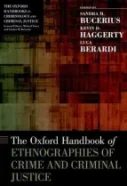The Oxford Handbook of Ethnographies of Crime and Criminal Justice
 Authors: Sandra M. Bucerius, Kevin D. Haggerty, & Luca Berardi
Authors: Sandra M. Bucerius, Kevin D. Haggerty, & Luca Berardi
Publisher: Oxford University Press, 2022. 656 pages.
Reviewer: Samantha McAleese | April 2024
The Oxford Handbook of Ethnographies of Crime and Criminal Justice (hereinafter referred to as the Handbook) is a good reference for criminologists and other social scientists who wish to learn more about qualitative and engaged forms of research. While the size of the Handbook might be intimidating, readers will find it easy to navigate to what is most relevant to their own work. The editors – Sandra M. Bucerius, Kevin D. Haggerty, and Luca Berardi – have compiled a good range of recent ethnographic research projects and methodological reflections, allowing both early-career and senior scholars to situate their work in conversation with each other.
Throughout the Handbook, readers will find a wealth of information about planning, organizing, implementing, and completing an ethnography. The work summarized in this collection successfully demonstrates many ways to do ethnography. Far from being a prescriptive methodological text, the Handbook offers a series of principles and guidelines that researchers should keep in mind as they embark on their own projects. The ‘tips and tricks’ provided in each chapter demonstrate a desire from more experienced ethnographers to offer guidance and support to those more unfamiliar with ethnographic research methods.
The introduction to the Handbook provides some context on the history and impact of ethnographic research in criminology. What some might appreciate here are the notes on how doing ethnography can help “challenge or debunk the considerable misinformation and mythology surrounding the lives of people” who are impacted by the criminal legal system (3). By engaging in the thick description required of ethnography, researchers can offer more nuanced stories of the data and narratives they collect throughout their time in the field. This deeper engagement helps move conversations about criminalization and punishment beyond the numbers.
Additionally, the introduction nods to how ethnographies might (or might not) be taken up by policymakers. The editors acknowledge that while it can be difficult to convince policymakers of the value of qualitative and narrative-based research, “in the right circumstances, ethnographic portrayals of marginalized, dispossessed, or suffering individuals can help spur public concern and motivate political action more so than any dispassionate statistical table” (10). While this point could have been made without minimizing the work of those who identify as activist scholars, I appreciate the focus here on work that offers a more nuanced understanding of the “illogical, unjust, and racist” criminal legal system. This conversation about the relationship between ethnography and policymaking is highlighted in Chapter 6, written by Keith Guzik and Gary T. Marx.
The front end of the Handbook continues with chapters that expand on the history of (crime) ethnography (Berardi), discuss the ethical challenges associated with doing ethnography (Haggerty), and offer practical guidance that will be especially helpful to criminologists and other scholars who are considering an ethnographic approach for the first time (Bucerius). Of note in Chapter 4 (Bucerius) are the critical reminders about positionality, reflexivity, and insider-outsider status. Bucerius writes that “[w]hen conducting ethnographic research, building rapport, and engaging with participants who might have very different life circumstances, crime ethnographers need to be intimately attuned to how their positionality plays a role in those interactions and the research process” (77). While leaving space for reflections on positionality and reflexivity might seem obvious to those who are well-trained in critical qualitative methodologies, this guidance is essential for budding ethnographers. Discussions of positionality appear throughout the Handbook and are highlighted again in Chapter 10, written by Holly Pelvin.
Different sections of this Handbook will resonate with each person who flips through the pages. Topics covered include but are not limited to: mixed methods research, global criminology, cultural criminology, narrative criminology, queer criminology, feminist ethnographies, organized crime, drug use, policing, courts, prisons, and prisoner reentry. I continue this review by highlighting a few chapters that stood out to me as significant contributions.
The first is Chapter 8, written by Heith Copes and Lynne M. Vieraitis, which provides guidance on organizing and conducting team ethnographies. The authors suggest that “working with a team may help overcome many of the challenges associated with solitary ethnographies” (156) and focus primarily on how this research approach “can produce a more comprehensive and trustworthy ethnography” (ibid). This contribution offers different examples of team ethnographies, discusses the advantages and limitations of this approach, and (like most chapters in the Handbook) concludes with policy implications and directions for future research. I think others will appreciate how this chapter offers an alternative to the, at times, isolating experience of doing academic work. Engaging in research alongside others who share interests can increase not only the quality of the work but also the potential for the findings to have meaningful impacts.
Chapter 14, written by Vanessa R. Panfil, highlights ethnographies in queer criminology. While, as the author notes, “very few ethnographies are explicitly queer criminology” (270), the studies that have been completed have “direct implications for policy and practice” (ibid). Furthermore, those who engage in queer criminological qualitative work often offer important critiques of “traditional [or mainstream] criminological theories, frameworks, and methods” (ibid) and therefore continue to push the boundaries of what is possible for critical and intersectional criminologists. This chapter includes an extended discussion of queer epistemology, further emphasizing the transformative potential of this particular framework. Panfil’s suggested directions for future ethnographic research are particularly important as they draw attention to the ongoing harms experienced by 2SLGBTQ+ people and the need to better understand their experiences within the criminal legal system.
Next, Chapter 15, written by Korey Tillman and Ranita Ray, focuses on feminist ethnographies of crime and deviance. This contribution challenges the androcentric tradition of criminology and, like the previous chapter, offers alternatives to more mainstream and positivistic approaches to criminological research. Tillman and Ray acknowledge the influence of Black feminism and how “[i]ntersectional frameworks are used within feminist ethnographies to question the power relationships between dominant and marginalized groups” (290). They also highlight institutional ethnography as a key methodological and theoretical framework that “calls for scholars to commence their analysis from the standpoint of women’s experiences” (297). This approach is particularly important for researchers working with criminalized and incarcerated women, as the various methods employed by institutional ethnographers help reveal the everyday realities of those who are impacted by and who work within and alongside the criminal legal system. Finally, this contribution highlights the strong links between feminist ethnographies and community activism. Tillman and Ray write that “feminist ethnography helps provide those on the margins the means to advance their own policy recommendations” (300) – indicating a more intentionally collaborative and political approach to research that will undoubtedly interest many criminologists.
Chapter 26, written by Max Travers, focuses on court ethnography – “a productive tradition that has contributed to our understanding of the criminal justice process” (512). This contribution offers a robust description of the history of court ethnography, summarizes key studies from the United States and Britain, introduces readers to recent work from Latin America, Australia, Canada, the Middle East, and China, and relays some practical challenges to conducting court ethnography. Near the end of the chapter, Travers highlights new trends in court ethnographies that are more critical and political in response to “a wider pattern of racial inequality and discrimination” (525) within court processes. Travers asserts that “[a]t a time of change in the legal system, it is more important than ever for the public to understand legal practice and institutions, and court ethnographies can play a key role in informing public debate about policy choices” (526). This is an important call to research that might be helpful to graduate students who are undecided about areas of interest.
In Chapter 28, Michael L. Walker offers ethnographic reflections on how people experience time while incarcerated. This contribution provides an important example of how ethnographers can combine their personal feelings and reflections on their experiences ‘in the field’ with sociological observations and analyses (556). This chapter also highlights the value of lived expertise to criminological knowledge, as Walker discloses his own experiences of criminalization and incarceration. Very practical suggestions and solutions are listed at the end of this chapter that focus on immediately improving the quality of life for incarcerated people, such as fixing clocks, adjusting mealtimes, and increasing access to outdoor recreational time. Finally, this chapter calls for more research on jails and, specifically, ethnographic and qualitative research projects that can deepen our “understanding of how (if at all) self-efficacy and hope vary over time, and if it matters whether a person has more or less social support” (567) while incarcerated.
The final contribution to the Handbook, Chapter 30, written by Andrea Leverentz, focuses on ethnographies of prisoner reentry. Leverentz demonstrates how “[e]thnographic work can illuminate processes shaping desistance and recidivism” (599) and how “ethnographic research can capture nuanced dynamics related to” (600) varying experiences of reentry. Throughout the chapter, we are reminded of how race, ethnicity, gender, and age (and the intersection of these individual characteristics) influence experiences of criminalization, punishment, and reentry and how the impacts of incarceration reach beyond the individual to their families and communities. While not titled as a conclusion to the Handbook, Leverentz’s section on policy implications leaves readers with important notes on the impact of ethnographies. The “compelling narratives and stories” gathered and shared by ethnographers “show the humanity of those portrayed” and “make visible taken-for-granted assumptions, and perhaps shine a light on how some of the assumptions are faulty or incomplete” (616). The role that ethnography plays in humanizing people impacted by the criminal legal system is vital when considering how many individuals continue to experience punishment and exclusion due to criminal records.
Overall, this new Oxford Handbook of Ethnographies of Crime and Criminal Justice will be a helpful resource for criminologists and other social scientists who wish to deepen their understanding of and ability to undertake meaningful ethnographic projects. Each contribution highlights “how ethnography can generate insights that go beyond the patterning of quantitative research” (Turner and Colombo, 384) and emphasizes the value of qualitative research in policymaking. It could be read alongside other texts that focus on more community-driven approaches, like political activist ethnography and Indigenous methodologies, to contribute to the decolonization, Indigenization, and social and political impacts of criminological research. The Handbook will be a good reference for graduate students (and their supervisors) who should consult the sections on directions for future research in the chapters that align with their research interests.
Samantha McAleese is an Assistant Professor at Brock University.


